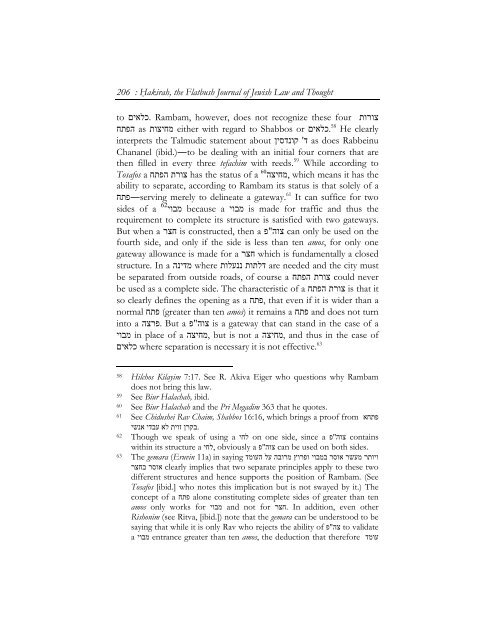King Solomon's Takanah: Rambam's Eruv - Hakirah.org
King Solomon's Takanah: Rambam's Eruv - Hakirah.org
King Solomon's Takanah: Rambam's Eruv - Hakirah.org
Create successful ePaper yourself
Turn your PDF publications into a flip-book with our unique Google optimized e-Paper software.
206 : Hạkirah, the Flatbush Journal of Jewish Law and Thought<br />
to .כלאים Rambam, however, does not recognize these four<br />
58 He clearly .כלאים either with regard to Shabbos or ת<br />
interprets the Talmudic statement about קונדסי ן ' as does Rabbeinu<br />
Chananel (ibid.)―to be dealing with an initial four corners that are<br />
then filled in every three tefachim with reeds. 59 While according to<br />
60<br />
Tosafos a צורת הפתח has the status of a ,מחיצה which means it has the<br />
ability to separate, according to Rambam its status is that solely of a<br />
serving―פתח merely to delineate a gateway. 61 It can suffice for two<br />
62<br />
sides of a מבוי because a מבו י is made for traffic and thus the<br />
requirement to complete its structure is satisfied with two gateways.<br />
But when a חצר is constructed, then a "פ can only be used on the<br />
fourth side, and only if the side is less than ten amos, for only one<br />
gateway allowance is made for a חצר which is fundamentally a closed<br />
structure. In a מדינה where לות are needed and the city must<br />
be separated from outside roads, of course a צורת הפתח could never<br />
be used as a complete side. The characteristic of a צורת הפתח is that it<br />
so clearly defines the opening as a ,פתח that even if it is wider than a<br />
normal פת ח (greater than ten amos) it remains a פתח and does not turn<br />
into a .פרצה But a "פ is a gateway that can stand in the case of a<br />
and thus in the case of ,מחיצה but is not a ,מחיצה in place of a מבוי<br />
effective. 63 where separation is necessary it is not כלאים<br />
צורות<br />
ד<br />
צוה<br />
דלתות ננע<br />
צוה<br />
מחיצו as הפתח<br />
58 Hilchos Kilayim 7:17. See R. Akiva Eiger who questions why Rambam<br />
does not bring this law.<br />
59 See Biur Halachah, ibid.<br />
60 See Biur Halachah and the Pri Megadim 363 that he quotes.<br />
פתחא 61 See Chidushei Rav Chaim, Shabbos 16:16, which brings a proof from<br />
.בקרן זוית לא עבדי אנשי<br />
62 Though we speak of using a לחי on one side, since a צוה "פ contains<br />
within its structure a ,לחי obviously a "פ can be used on both sides.<br />
ויותר מעשר אוסר במבוי ופרוץ מרובה על העומד 63 The gemara (<strong>Eruv</strong>in (11a in saying<br />
clearly implies that two separate principles apply to these two אוסר בחצר<br />
different structures and hence supports the position of Rambam. (See<br />
Tosafos [ibid.] who notes this implication but is not swayed by it.) The<br />
concept of a פתח alone constituting complete sides of greater than ten<br />
amos only works for מבו י and not for .חצר In addition, even other<br />
Rishonim (see Ritva, [ibid.]) note that the gemara can be understood to be<br />
saying that while it is only Rav who rejects the ability of "פ to validate<br />
עומד entrance greater than ten amos, the deduction that therefore מבוי a<br />
צה<br />
צוה
















